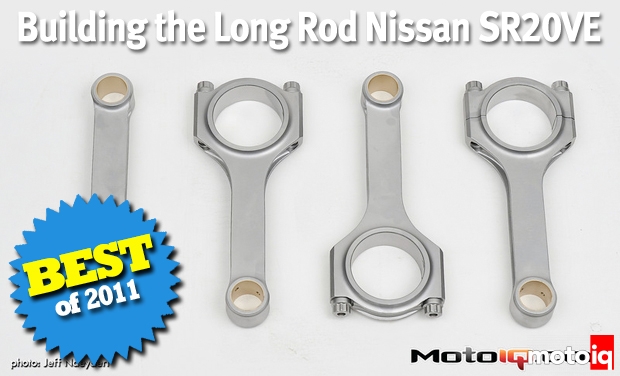,
To accomplish the slim weight of 271 grams, JE Pistons also utilized their 3D under crown manufacturing process. JE Pistons’ 3D under crown process is an intricate milling operation which optimizes thicknesses across the piston’s crown for the thermal and mechanical loads that they will experience. Essentially, the 3D under crown cuts out all the unnecessary fat.
 |
 |
| You can see the under crown milling details here as well as checking for oil squirter clearance. |
JE carved the pistons from forged 2618 low silicon aluminum alloy forgings. Low silicon alloys are much tougher than castings and high silicon alloy forgings such as those made from 4032 or MS75 alloys. The primary disadvantage of 2618 is that low silicon alloys have is a higher coefficient of expansion. This means that a piston forged from 2618 has to run a bigger piston to wall clearance than a high silicon forging or a cast piston. Typically a cast piston in our bore size can run clearances as little as 0.0003” to 0.0015″ and a 4032 piston can run clearances at around from 0.0025″ to 0.0030”. 2618 pistons usually run clearances of 0.0030″ to 0.005” depending on the end use. Of course these are generalities and piston clearances can vary greatly depending on several factors such as induction method, application, and different bore materials and coatings.
 |
| Our JE pistons are state of the art works of art. |
A disadvantage of the larger clearance is greater noise, greater oil consumption and perhaps accelerated wear of the bores, piston and rings. A lot of these disadvantages are mitigated by JE’s advanced skit profiles. JE uses FEA for both mechanical stress and thermal analysis to generate skirt profiles that match the thermal profile of the piston as well as developing side profiles that load the piston skirt in a rocking rather than a slapping motion. This allows the engineers to design a skirt to minimize piston slap so a 2618 piston can be fairly quiet and run tighter clearances than typical low silicon alloy. In other words, you can have the toughness of 2618 with less of the disadvantages.
 |
| A close up shot shows the details of the intricate under crown milling. |
To top off our long rod SR20VE pistons, JE Pistons utilizes a lightweight and low tension ring pack. The thin rings are 1.0, 1.2, 2.8 mm for the top compression, 2nd compression and oil control rings respectively. The reduced axial and radial widths of the ring pack make it lightweight, which helps minimize the inertial forces that cause ring flutter and poor ring seal.
 |
| The difference in surface area between the major and minor thrust areas. You can also see the “Tuff” skirt anti-friction coating. |
The top compression ring is steel with a gas nitrided surface treatment, and a barrel face contour. The barreled face helps ensure that the ring will continue to effectively seal as the piston tilts from side to side in secondary motion. The particular alloy of this top compression ring also has an exceptional tension reduction rate at high temperatures, losing less than 4% of its tension at 400° C. The top ring’s gas nitride hardening process results in a thin, hard, low friction layer that simultaneously provides higher wear resistance than most conventional rings. The gas nitride coating also promotes a more consistent heat transfer rate than most chrome rings, as the heat is not transferred as well through dissimilar materials. This is important as the rings are the first heat path away from the piston and a lot of the pistons thermal load is dissipated through the rings.
 |
| Our piston has a compression height (pin height) of .994″ to accomodate the longer H22 rod. This places the pin bore into the oil ring groove, which some attribute to oil control issues. However, we have not observed any oil consumption issues with our motor yet. You can also see the lustrous surface of the WPC treated areas. |
 |
| The side contour details are shown here. The accumulator groove buffers pressure below the first compression ring improving seal. The undercut on the third land helps second ring function by also reducing pressure underneath it and the relief below the oil ring also relieves under ring pressure and gives oil a place to go. |
One feature worth mentioning is the second ring land accumulator groove. The accumulator groove increases the volume underneath the first compression ring. Increasing this second land volume helps reduce the amount of pressure build up from gases that have escaped past the compression ring. A high amount of pressure below the compression ring can disrupt ring seal, causing blow by. In the same sense, undercutting the diameter of the ring land can accomplish the same thing.
Underneath the oil ring groove is another commonly overlooked, yet important feature. On our particular piston, a square relief has been cut below the oil ring groove. This relief promotes better oil control as it reduces the chance of pressure build up underneath the oil ring, which can cause oil to momentarily dislodge the oil rings seal from the cylinder wall and allow oil to blow by the oil ring’s scrapers. The relief also provides a path for excess oil to travel around the piston to a drain back hole or less loaded areas beneath the oil ring. A small radius or chamfer underneath the oil ring can also act in the same fashion, but will also help channel the oil into the groove.




5 comments
I’m considering building a long rod sr20vvl rwd motor but am having issues getting the information that I need to purchase the Pistons from JE. Would you be willing to share the piston info so I can get a copy of these Pistons for my motor?
Unfortunately, this was so long ago, I forgot the build number, but several motors have been done from this combo so they have the design.
what is the part number of the pistons to use with h22 cranks?
It’s an H22 rod, not a crank. Its a custom JE piston.
Mike,
Was there any power improvements over time?
Perhaps I missed it, but how much longer (degrees of rotation) do the pistons hang out at TDC vs the standard rod?
Regards,